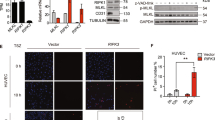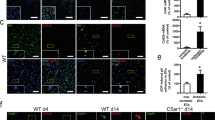Abstract
The angiopoietins Ang-1 and Ang-2 have been identified as ligands of the receptor tyrosine kinase Tie-2 (refs. 1,2). Paracrine Ang-1–mediated activation of Tie-2 acts as a regulator of vessel maturation and vascular quiescence3,4. In turn, the antagonistic ligand Ang-2 acts by an autocrine mechanism5,6,7 and is stored in endothelial Weibel-Palade bodies from where it can be rapidly released upon stimulation8. The rapid release of Ang-2 implies functions of the angiopoietin-Tie system beyond its established role during vascular morphogenesis as a regulator of rapid vascular responses. Here we show that mice deficient in Ang-2 (encoded by the gene Angpt2) cannot elicit an inflammatory response in thioglycollate-induced or Staphylococcus aureus–induced peritonitis, or in the dorsal skinfold chamber model. Recombinant Ang-2 restores the inflammation defect in Angpt2−/− mice. Intravital microscopy showed normal TNF-α–induced leukocyte rolling in the vasculature of Angpt2−/−mice, but rolling cells did not firmly adhere to activated endothelium. Cellular experiments showed that Ang-2 promotes adhesion by sensitizing endothelial cells toward TNF-α and modulating TNF-α–induced expression of endothelial cell adhesion molecules. Together, these findings identify Ang-2 as an autocrine regulator of endothelial cell inflammatory responses. Ang-2 thereby acts as a switch of vascular responsiveness exerting a permissive role for the activities of proinflammatory cytokines.
This is a preview of subscription content, access via your institution
Access options
Subscribe to this journal
Receive 12 print issues and online access
$209.00 per year
only $17.42 per issue
Buy this article
- Purchase on Springer Link
- Instant access to full article PDF
Prices may be subject to local taxes which are calculated during checkout




Similar content being viewed by others
References
Maisonpierre, P.C. et al. Angiopoietin-2, a natural antagonist for Tie2 that disrupts in vivo angiogenesis. Science 277, 55–60 (1997).
Davis, S. et al. Isolation of angiopoietin-1, a ligand for the TIE2 receptor, by secretion-trap expression cloning. Cell 87, 1161–1169 (1996).
Suri, C. et al. Requisite role of angiopoietin-1, a ligand for the TIE2 receptor, during embryonic angiogenesis. Cell 87, 1171–1180 (1996).
Thurston, G. et al. Leakage-resistant blood vessels in mice transgenically overexpressing angiopoietin-1. Science 286, 2511–2514 (1999).
Gale, N.W. et al. Angiopoietin-2 is required for postnatal angiogenesis and lymphatic patterning, and only the latter role is rescued by Angiopoietin-1. Dev. Cell 3, 411–423 (2002).
Stratmann, A., Risau, W. & Plate, K.H. Cell type-specific expression of angiopoietin-1 and angiopoietin-2 suggests a role in glioblastoma angiogenesis. Am. J. Pathol. 153, 1459–1466 (1998).
Zhang, L. et al. Tumor-derived vascular endothelial growth factor up-regulates angiopoietin-2 in host endothelium and destabilizes host vasculature, supporting angiogenesis in ovarian cancer. Cancer Res. 63, 3403–3412 (2003).
Fiedler, U. et al. The Tie-2 ligand angiopoietin-2 is stored in and rapidly released upon stimulation from endothelial cell Weibel-Palade bodies. Blood 103, 4150–4156 (2004).
Hobson, B. & Denekamp, J. Endothelial proliferation in tumours and normal tissues: continuous labelling studies. Br. J. Cancer 49, 405–413 (1984).
Folkman, J. The role of angiogenesis in tumor growth. Semin. Cancer Biol. 3, 65–71 (1992).
Eberhard, A. et al. Heterogeneity of angiogenesis and blood vessel maturation in human tumors: implications for antiangiogenic tumor therapies. Cancer Res. 60, 1388–1393 (2000).
Thurston, G. et al. Angiopoietin-1 protects the adult vasculature against plasma leakage. Nat. Med. 6, 460–463 (2000).
Ramsauer, M. & D'Amore, P.A. Getting Tie(2)d up in angiogenesis. J. Clin. Invest. 110, 1615–1617 (2002).
Jeon, B.H. et al. Tie-ing the antiinflammatory effect of angiopoietin-1 to inhibition of NF-κB. Circ. Res. 92, 586–588 (2003).
Gamble, J.R. et al. Angiopoietin-1 is an antipermeability and anti-inflammatory agent in vitro and targets cell junctions. Circ. Res. 87, 603–607 (2000).
Nykanen, A.I. et al. Angiopoietin-1 protects against the development of cardiac allograft arteriosclerosis. Circulation 107, 1308–1314 (2003).
Wong, A.L. et al. Tie2 expression and phosphorylation in angiogenic and quiescent adult tissues. Circ. Res. 81, 567–574 (1997).
Hanahan, D. Signaling vascular morphogenesis and maintenance. Science 277, 48–50 (1997).
Scharpfenecker, M., Fiedler, U., Reiss, Y. & Augustin, H.G. The Tie-2 ligand angiopoietin-2 destabilizes quiescent endothelium through an internal autocrine loop mechanism. J. Cell Sci. 118, 771–780 (2005).
Pitera, J.E., Woolf, A.S., Gale, N.W., Yancopoulos, G.D. & Yuan, H.T. Dysmorphogenesis of kidney cortical peritubular capillaries in angiopoietin-2–deficient mice. Am. J. Pathol. 165, 1895–1906 (2004).
Chavakis, T. et al. Staphylococcus aureus extracellular adherence protein serves as anti-inflammatory factor by inhibiting the recruitment of host leukocytes. Nat. Med. 8, 687–693 (2002).
Butcher, E.C. & Picker, L.J. Lymphocyte homing and homeostasis. Science 272, 60–66 (1996).
Vajkoczy, P., Schilling, L., Ullrich, A., Schmiedek, P. & Menger, M.D. Characterization of angiogenesis and microcirculation of high-grade glioma: an intravital multifluorescence microscopic approach in the athymic nude mouse. J. Cereb. Blood Flow Metab. 18, 510–520 (1998).
Lejeune, F.J., Ruegg, C. & Lienard, D. Clinical applications of TNF-α in cancer. Curr. Opin. Immunol. 10, 573–580 (1998).
Oliner, J. et al. Suppression of angiogenesis and tumor growth by selective inhibition of angiopoietin-2. Cancer Cell 6, 507–516 (2004).
Lehr, H.A., Vollmar, B., Vajkoczy, P. & Menger, M.D. Intravital fluorescence microscopy for the study of leukocyte interaction with platelets and endothelial cells. Methods Enzymol. 300, 462–481 (1999).
Vajkoczy, P. et al. Microtumor growth initiates angiogenic sprouting with simultaneous expression of VEGF, VEGF receptor-2, and angiopoietin-2. J. Clin. Invest. 109, 777–785 (2002).
Acknowledgements
We thank B. Joos (Freiburg) and S. Lüke (Berlin) for technical assistance, and N. Esser (Freiburg) and K. Kruse (Freiburg) for support in the maintenance of mouse colonies and experimental models. This work was supported by the Deutsche Forschungsgemeinschaft (SFB-TR23, subproject A3 (to H.G.A.), SFB-TR23, subproject C2 (to P.V.), Fi879/1-3 (to U.F.), He1850/6-2 (to M.H.) and Pr372/18-2 (to K.T.P.)) and Austrian Science Fund (FWF JRP “Angiogenesis,” subproject 4 (to H.G.A.)).
Author information
Authors and Affiliations
Corresponding author
Ethics declarations
Competing interests
The authors declare no competing financial interests.
Supplementary information
Supplementary Fig. 1
Breeding statistics of Ang-2-deficient mice bred in the C57Bl6 background and in the 129/J background. (PDF 19 kb)
Supplementary Fig. 2
Ang-2 expression and storage in human tissues. (PDF 65 kb)
Supplementary Fig. 3
Analysis of cells recruited into the lung of wild type and Ang2-deficient mice after Streptococcus pneumoniae infection. (PDF 30 kb)
Supplementary Fig. 4
Tie2 expression in different cell populations. (PDF 47 kb)
Supplementary Video 1
Baseline leukocyte rolling in wild-type mice. (MPG 1985 kb)
Supplementary Video 2
Baseline leukocyte rolling in Angptl2−/− mice. (MOV 1287 kb)
Supplementary Video 3
Leukocyte adhesion in wild-type mice 1 h after TNF-α treatment. (MOV 1111 kb)
Supplementary Video 4
Leukocyte rolling in Angptl2−/− mice 1 h after TNF-a treatment. (MOV 1312 kb)
Rights and permissions
About this article
Cite this article
Fiedler, U., Reiss, Y., Scharpfenecker, M. et al. Angiopoietin-2 sensitizes endothelial cells to TNF-α and has a crucial role in the induction of inflammation. Nat Med 12, 235–239 (2006). https://doi.org/10.1038/nm1351
Received:
Accepted:
Published:
Issue Date:
DOI: https://doi.org/10.1038/nm1351
This article is cited by
-
Electroacupuncture alleviates ventilator-induced lung injury in mice by inhibiting the TLR4/NF-κB signaling pathway
BMC Anesthesiology (2024)
-
Potential role between inflammatory cytokines and Tie-2 receptor levels and clinical symptoms in patients with first-episode schizophrenia
BMC Psychiatry (2023)
-
Effects of needle puncturing on re-vascularization and follicle survival in xenotransplanted human ovarian tissue
Reproductive Biology and Endocrinology (2023)
-
Randomized, double-blind, placebo-controlled, crossover trial of oral doxycycline for epistaxis in hereditary hemorrhagic telangiectasia
Orphanet Journal of Rare Diseases (2022)
-
The natural compound atraric acid suppresses androgen-regulated neo-angiogenesis of castration-resistant prostate cancer through angiopoietin 2
Oncogene (2022)



